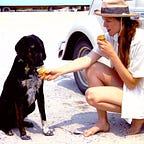Wait, But I’m a Heroine
Sometimes when I’m teaching a lesson about Joseph Campbell’s Hero’s Journey story structure, I see my female seventh graders’ eyes glaze over. I reference the hero, and often the movie clips we show or movies we reference are of Luke, Harry, Frodo or Samwise, Tony, Miles Morales and many, many other male leads. Campbell wrote “The Hero With a Thousand Faces” in 1949, in the midst of not only a male-centric modern era but steeped in a history that told stories only of men while women watched from the sidelines.
I had coffee with two friends in a Los Angeles hood fondly known as Frogtown, which runs along the LA River. Le Columbe is a coffee shop perched beside the cement path that runs along the largely concrete river. I’m at a point with this “Hero’s-Journey-and-Me” project where I want to bounce it off anyone and everyone who will listen. I yearn for words of encouragement, votes of confidence and virtual high fives that yes, there is an audience out there for this modern-yet-ancient journey.
One of my friends, I’ll call her Leia, sipped her tea and asked what I had been working on lately. I began to describe my idea of saving myself with the Hero’s Journey, and I started off by asking: “Have you heard of Joseph Campbell’s concept of the Hero’s Journey?” She looked at me as though we had just met for the first time. “Yes,” she said perfunctorily. That’s when I started kicking myself. Leia had spent a decade working for Pixar, a company not only jam-packed with skilled storytellers, but famous for emphasizing the importance of story structure in their hit movies.
Sheepishly, I backtracked, saying, “Of course I know that you know... duh.” It was like asking a film student if they had heard of Fellini, or a psychotherapist if they had heard of Freud. Leia put a warm hand on mine.
“Your project sounds great,” she began, “and have you read about the female archetype? There’s this one book I love…” she said and began scrolling through her phone to find the title.
Leia flashed the covers of The Heroine’s Journey by Maureen Murdock, and Women Who Run with the Wolves by Clarissa Pinkola Estes, PhD. And that’s why I love my friends. Because they educate me gently and lovingly, because they are the types of women who pay attention to what matters deep within me. Our synchronicity is clear.
I’m working on a way to work in examples of the heroine’s journey, but the trick is I’m teaching seventh grade, not Women’s Studies at university. I figure I’ll start with using movies and novels with female leads they can relate to, such as The Hunger Games, The Hate U Give, Twilight, Spirited Away, Mean Girls, Wrinkle in Time, Maleficent and the rest of the Disney movies with female leads (ahem, often princesses, although in the latest, Encanto, the female lead is not a princess).
I do have non-binary, gender fluid students, and in this realm I have very few examples where they would see representation. What I will do in the meantime is teach the Hero’s Journey as a journey for all, and the term “hero” should be looked at as a non-gender-influenced noun (yes I just made that up). The journey, the conflict, decisions, wants, needs, refusals and supporting characters are more important than the who, in a sense. I just need to be thoughtful about my examples.
Female archetypes aren’t equivalent to talking about a story structure that has been used for centuries, however they are intertwined. Especially for this one, me, who is starting on her own journey. A journey that has begun, in these pages, in that cafe along that slim river, and in my heart.
